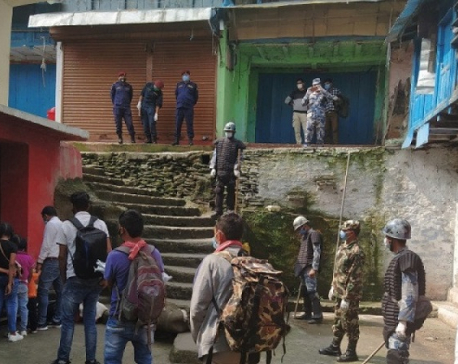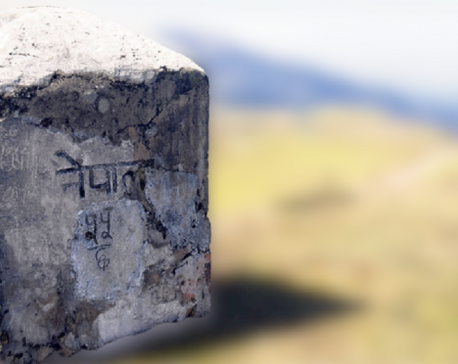
OR

Let us use all our avenues and diplomatic acumen to resolve the issue with our southern neighbor through a peaceful, well-thought-out process
For the past few days, the Kalapani-Lipulek-Limpiyadhura has remained the lead story for the Nepali media. In a rare show of unity, Nepal's political parties from the left, right and the centre have come together against India's territorial aggression on Nepal's region of strategic importance close to the China border, formalized by cartographic aggression, though the ruling political party seems a bit reluctant when it comes to using all avenues to resolve issues of Indian encroachment upon Nepali territories even as student wings continue to hit the streets against this aggression.
Sensing reluctance
This may partly be due to the fact that the CPN-UML, at least a segment of it, was the one that had gone all out in favor of the very controversial Mahakali Treaty that ended up drastically weakening Nepal's water sovereignty, by promising that the treaty would herald a new dawn of prosperity from the West (Far-West). It is possible that the party, which has now transformed into the NCP, still believes that the treaty would somehow bring about national prosperity despite the fact that it has effectively handed over the vital river system to India and brought about progress and prosperity in Uttarakhand and Uttar Pradesh at the expense of Nepal and the Nepalis. It is also possible that the ghosts from the past would wake up and start tormenting, at least, a segment of the ruling party if it were to raise this issue of national importance by channelizing all energies.
This is indicated by the fact that Co-chair of the ruling NCP, Pushpa Kamal Dahal toned down his rhetoric a bit saying recently that it is too early to internationalize the issue (take the issue to the United Nations?) for obvious reasons. The political leadership in charge seems to be going again for tried and tested methods that have failed to resolve the issue of territorial encroachment, including of the Kalapani-Lipulek-Limpiadhura region, instead of holding a one-on-one meeting between Prime Minister KP Sharma Oli and Indian counterpart Narendra Modi, because it means dealing with both the not-so-cuddly elephant and the fiery dragon at the same time, as if dealing with the jumbo alone were not enough.
This reluctance will only boost the morale of a Bharatiya Janata Party (BJP) government—an emerging Third Reich of sorts in its own right—bent on further subjugating countries in the immediate neighborhood.
Meanwhile, efforts to weaken the movement against this aggression seem to have begun in right earnest. Consider the following.
One, the main opposition Nepali Congress has started pointing at Chinese encroachment upon Nepali territories. Of course, there are reports of China encroaching upon Nepali territories and we should stand against all forms of aggression. But, at this juncture, raising this issue is akin to a weak army fighting on multiple battlefronts. At this moment, let us channelize all our energies. Let us use all our avenues and diplomatic acumen to resolve the issue with our southern neighbor through a peaceful, well-thought-out process. Once the process is on track, we can raise the issue of Chinese aggression, also in view of the fact that the scale of aggression is far less than Indian aggression.
Second, vested interests have started maligning the movement by charging that a certain country is fuelling the fire. Yours truly feels that this charge undermines the capacity of the Nepalis to know what is right for them and for their country. It is an affront to the patriotic Nepalis and is part of desperate attempts to weaken the movement. Nonetheless, we shall ever be watchful against such nefarious elements and wage a long and hard but peaceful struggle for the restoration of national sovereignty that has come under attack not only in the Kalapani-Lipulek-Limpiadhura region but also in Susta-Maheshpur, Pashupatinagar and many other parts of this country (reports suggest that 21 out of 26 districts adjoining the southern neighbor are suffering territorial aggression).
Third, when national forces are standing together for national sovereignty through a rare show of unity, a different movement was gaining strength in Dadeldhura until Tuesday. The doctor involved in spearheading this medical movement and his die-hard followers may be fighting for a noble cause and may, one fine day, be able to free national medical education from the clutches of the much-hyped national medical media. Will they start their fight against the international medical mafia once they are done with finishing off the national medical mafia? Will they gather courage some day to also take on that mafia, which is sending millions of Nepali medical students to foreign colleges (many with questionable credentials) by charging hefty fees after tarnishing the image of Nepal's medical institutions beyond repair?
Is this medical strike in line with the Hippocratic Oath? If it is not, are the docs in protest taking some other oath? People have the right to know and the docs have the duty to answer.
Having said this, will it be asking for too much to these agitators to come join a peaceful campaign for national sovereignty and take it to new heights so that we all can live in Nepal with honor and dignity instead of having to live as a subjugated people?
President’s visit
Meanwhile, the president of a neighboring country is in Nepal visit. He is welcome but yours truly does not know what this visit is all for. Is it meant to increase land connectivity with that country, despite the fact that there's no escaping our southern neighbor even in this new scheme as the land route will pass through her territories? Is it meant to facilitate the export of our hydropower to the (relatively) distant neighbor using the territory of the southern neighbor? It should be noted that this country, as per media reports, is seeking to import from our country around 9,000 MW of hydroelectricity after the construction of some mega projects. Does the government still think that export of hydropower—and not its full utilization in Nepal for industrialization, operation of electric transport systems and for decreasing dependency on imported fossil fuel—will bring about national prosperity?
Or does this visit have some other purpose, given that our southern neighbor is rendering stateless a huge number of what it calls refugees from the country whose president is in Nepal visit?
I want these speculations to be proved wrong, though.
You May Like This

378 Nepalis rescued from Nepal-India border in Baitadi
BAITADI, May 23: As many as 378 Nepali citizens including four grieving family members stranded along the Nepal-India border in... Read More...

103 border pillars missing in Banke and Bardiya districts
BANKE, Nov 20: Five hundred and fifty-two pillars have been maintained from Gurdengauri of Banke to Karnali River in Bardiya... Read More...

Waterways to be built up to Nepal-India border areas
NEW DELHI Feb 12 : Visiting Minister for Energy, Water Resource and Irrigation Barshaman Pun and Indian Minister for Water Resource, River... Read More...

Just In
- Indians vote in the first phase of the world’s largest election as Modi seeks a third term
- Kushal Dixit selected for London Marathon
- Nepal faces Hong Kong today for ACC Emerging Teams Asia Cup
- 286 new industries registered in Nepal in first nine months of current FY, attracting Rs 165 billion investment
- UML's National Convention Representatives Council meeting today
- Gandaki Province CM assigns ministerial portfolios to Hari Bahadur Chuman and Deepak Manange
- 352 climbers obtain permits to ascend Mount Everest this season
- 16 candidates shortlisted for CEO position at Nepal Tourism Board







_20220508065243.jpg)










Leave A Comment